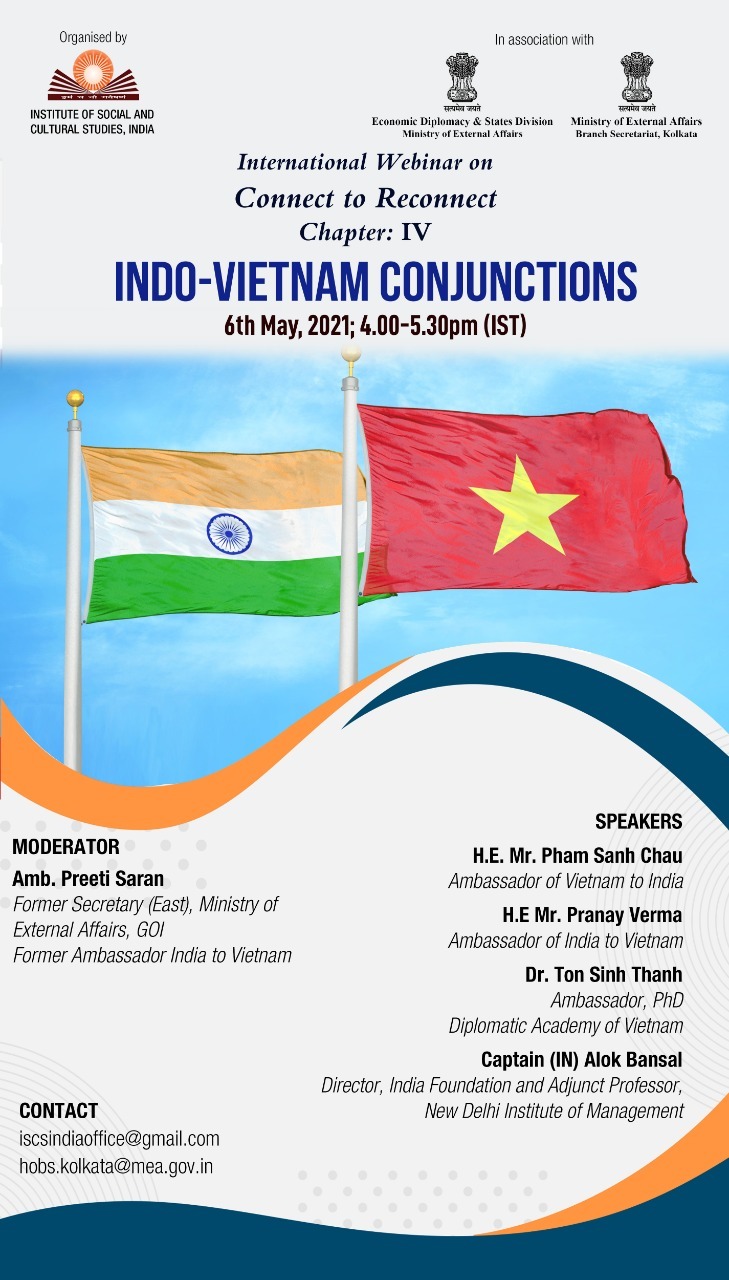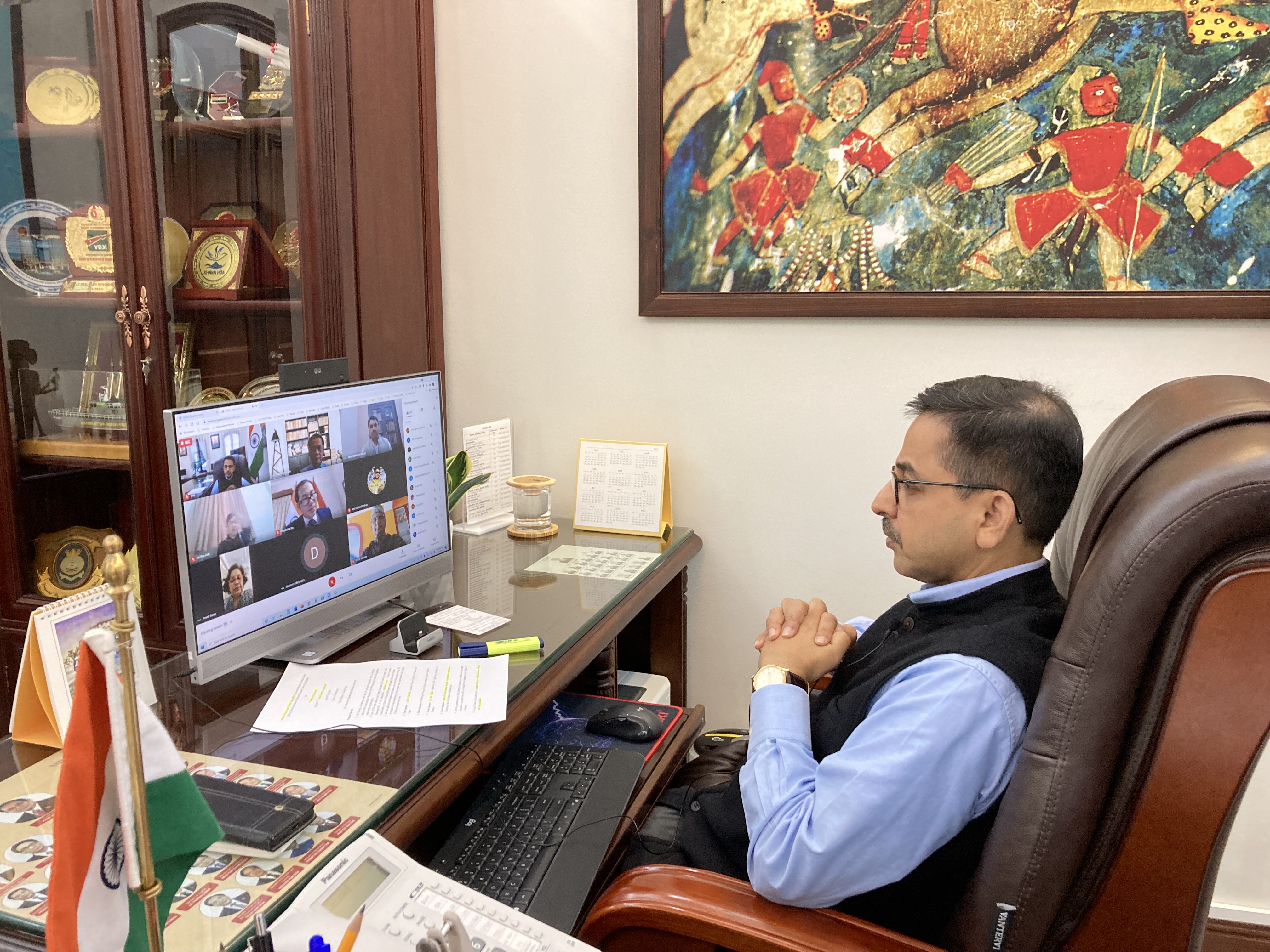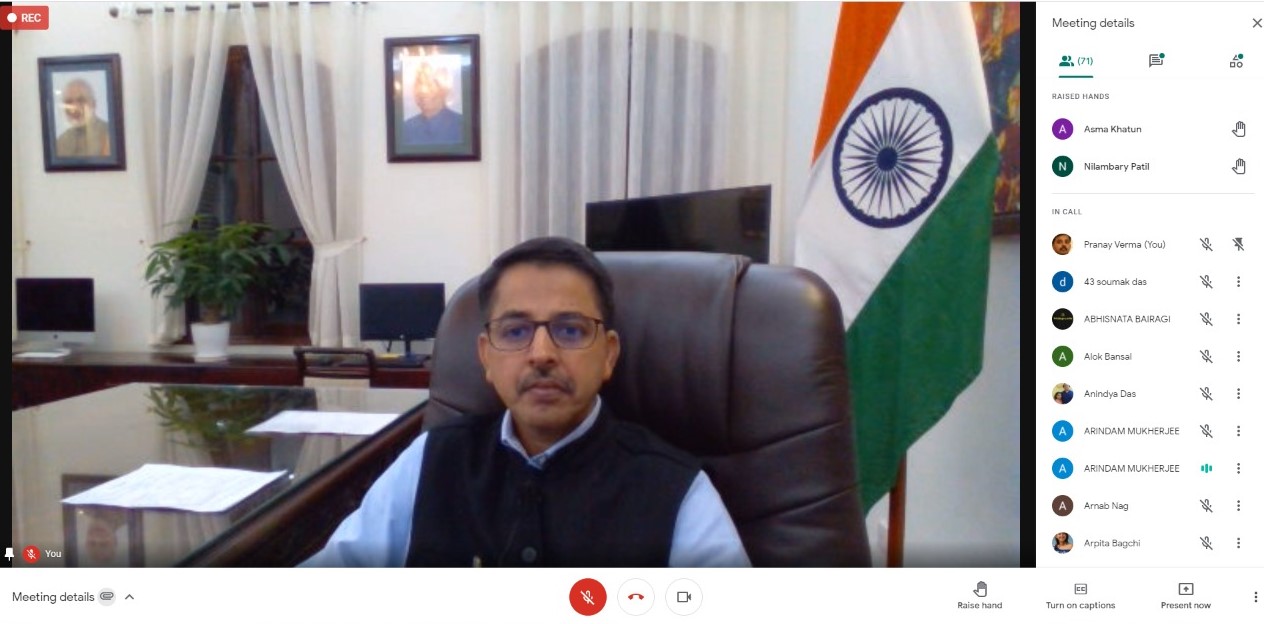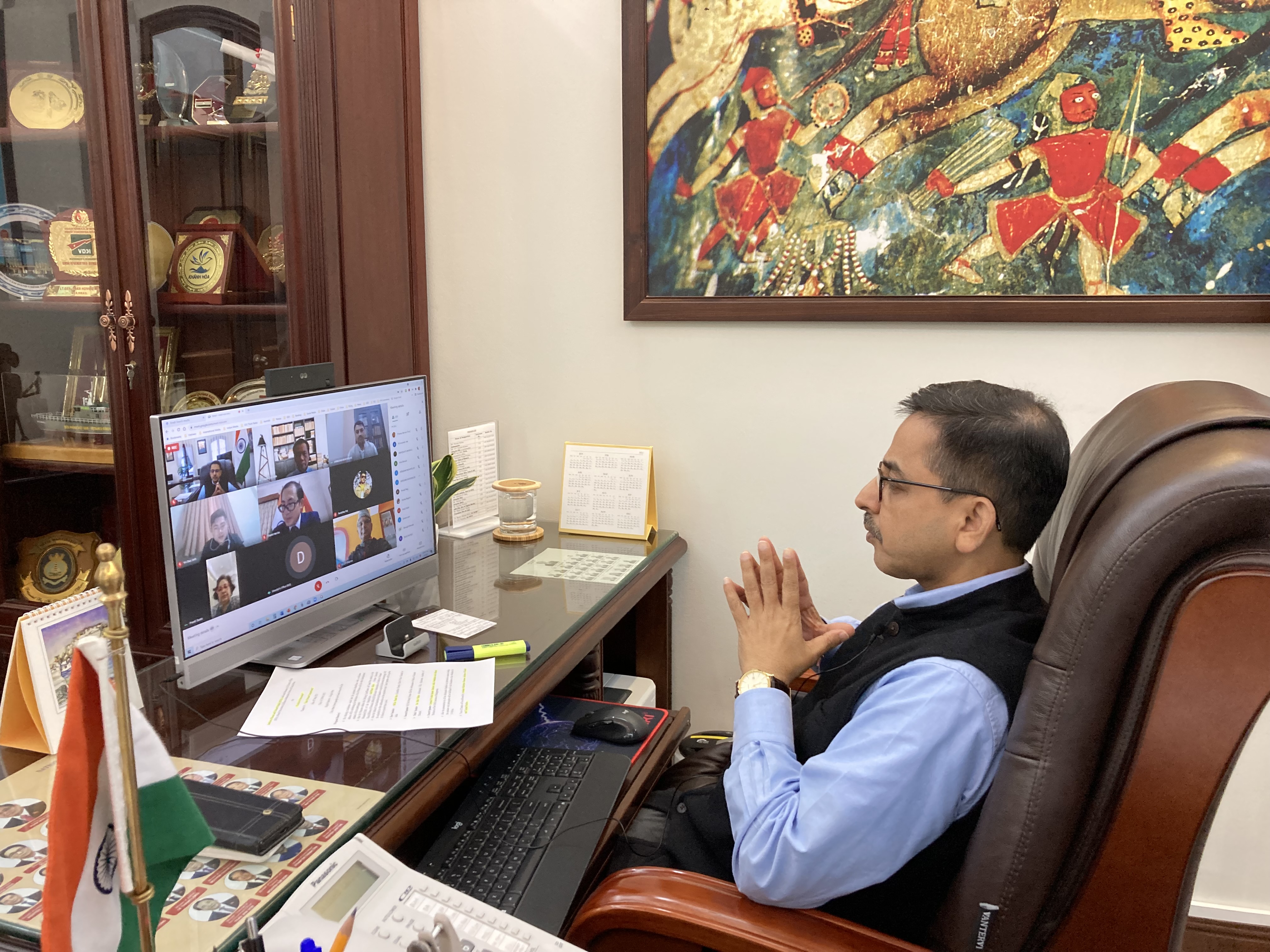
It is good to see many colleagues on this webinar today and to hear their remarks.
It is difficult to sound different when you are talking about India-Vietnam relations among people who have got such profound experience of this relationship. And therefore, I may be repeating many of the things that have already been spoken by previous speakers.
Let me try and focus on the “connectivity” part of the theme.
Before I do that, I would like to convey my sincere thanks to Institute of Social and Cultural Studies for taking this initiative. In the midst of the COVID pandemic, webinars are really the way to connect, and it really shows how technology and digital connectivity have become integral parts of our existence and professional lives today. So, thank you very much for giving us this opportunity and for bringing us all together.
I would like to focus on, as I said, the connectivity and connection part of today’s theme. Connectivity is indeed one of the most important enablers for realising the potential of any relationship, not the least a profound Comprehensive Strategic Partnership like ours with Vietnam. Historically, we all know how India and Vietnam were connected through maritime routes that brought cultural and religious affinity between our societies as well as trade and intellectual exchanges that took place over millennia.
So indeed, what we are talking today is “reconnecting”, which makes the title of today’s discourse “Connecting to Reconnect” quite apt.
As Ambassador Saran mentioned, ‘connectivity’ is one of the three important ‘C’s on which our Act East Policy is founded – the other two being ‘commerce’ and ‘culture’.
But we also need to take a more holistic view of connectivity, that covers not just the physical sense of the term but also its manifestations in the digital space – as we are doing today, as also our economic connections, our cultural and societal connections, and institutional connections in the broader sense.
In the post-COVID times, the revival of engagement and shared growth will largely depend on the effectiveness of our efforts towards reconnection.

Among the key areas of our engagement, of course, political connections have acquired new momentum. High-level exchanges are very important catalysts to our overall relationship. Even during the COVID pandemic last year, we maintained that momentum of these exchanges, which speaks volumes about the intensity and intent on both sides to maintain this political dialogue and connection.
We used technology to trump physical barriers. Our leaders connected on numerous occasions – through phone calls between Prime Ministers, institutional dialogues between Foreign Ministers through the Joint Commission Meeting, Defence Ministers’ Dialogue, ASEAN meetings which Vietnam led last year and so on. We saw that series of important conversations culminating in the Virtual Summit in December 2020, which though virtual, probably one of our most substantive engagements in recent times. It was during the Virtual Summit that our leaders adopted the first-ever Joint Vision document, rather than a ‘joint statement’, which provided a blueprint for the development of the relationship, not for a year or two, but in a very long-term strategic perspective. The fact that we were able to do that in a year when we saw physical visits completely stymied by the COVID disruptions, shows our political commitment to the future of the relationship.
We also were able to do much for our defence exchanges. The Lines of Credit which enabled us to cooperate with Vietnam in defence industry moved forward with new achievements, as we delivered the first high-speed guard boats last year to the Vietnam Border Guard Command. Our military medical teams also stayed in close contact to discuss ways to deal with COVID pandemic. So, overall, there has been a very purposeful and positive intent to engage despite the disruptions of the pandemic.
Let me talk about our business and economic connections.
I think in 2020, I attended more business webinars and B2B engagements than I probably would have done otherwise. And in some way, this reflected the realization, and something that I always believe, that COVID is an opportunity in crisis. As we were pushed out of our comfort zones and as we suffered disruptions, the pandemic forced us to rethink business as usual and to explore new partnerships and supply chains. In exploring these new partnerships and looking for resilient and trust-based supply chains, we have started looking at each other with greater interest.
So, at the end of the year, despite the disruptions, we were able to reach US$ 10 billion of bilateral trade between India and Vietnam, which I think is commendable. Of course, we are well below what I believe is our potential as the two of the fastest growing economies in the region, But in the given situation of unprecedented disruptions, the importance of this level of trade engagement cannot be belittled.
Apart from trade, there is also investment interests coming from both sides. We are seeing a renewed interest in investment in areas like infrastructure, energy, IT. We are noticing Vietnamese investors enquiring about opportunities in India. This is a good trend. As we have more big investors emerging in Vietnam and as Vietnam’s economic capabilities grow and its companies look outwards for opportunities, India is one destination that we would urge them to look at.
The new opportunities emerging in India are very clear as India is trying to get past the COVID disruptions and integrating more intently with global value chains through the vision of “Aatmanirbhar Bharat” or “Self-Reliant India” which is actually about creating capacities at home through closer global partnerships. This, together with India’s target of becoming a US$ 5 trillion economy as well as Vietnam’s vision for becoming a high-income developed economy by 2045, provides the overall strategic perspective though which our business communities must look at each other for long-term opportunities.
 Coming to Cultural Connections.
Coming to Cultural Connections.
I would say that we achieved new milestones and launched new initiatives last year. Cooperation in heritage conservation is one notable area of our collaboration, which has been successful in rekindling our cultural affinity and bringing cultural dimensions of our engagement into sharper relief. The example I would give is of the discovery of the Shivalingam in My Son in Quang Nam province of Vietnam, where we are working on the conservation of the ancient Cham monuments. It received a lot of media coverage. We have decided to do three more similar conservation projects in different provinces of Vietnam as announced by our leaders during the Virtual Summit. Then, we also saw two important cultural icons of India Ganesha and Gajasimha being designated as National Treasure of Vietnam by the Vietnamese Government. That development also resonated very well among the people of India and brought home the point that we are so much more closely connected culturally than we generally imagine.
The project for creating an Encyclopaedia on India-Vietnam cultural and civilizational contacts, is another initiative that we have embarked upon. We are trying to build a treasure trove for the future generation by compiling together and putting in one place a rich, but scattered history of our past connections. There is nothing like that kind of a resource available at one place. So, we believe that the encyclopaedia will be an important means to educate our younger generation about the profoundness of our cultural affinity.
Buddhist linkage is another area of emphasis. We have just launched in our Cultural Centre in Hanoi a project for developing an interactive platform providing have a comprehensive depiction of India-Vietnam Buddhist linkages.
Our societal connections are also growing. We have an Indian diaspora in Vietnam, which is becoming more visible. Their number is about 5500 but it is growing. The diaspora in any country plays an important role in bilateral relations. We hope that our diaspora will provide a valuable bridge to bring our societies closer. When the direct flights started in 2019, there was a visible increase in the number of Indians on the streets of Hanoi. Unfortunately, as direct flights stopped after the pandemic’s onset, that process was disrupted. I do hope that the resumption of these flights will bring many more visitors in both directions to nurture the connection between our societies.
Connecting our youths is extremely important if we are really serious about reinforcing our connections in future. For this, during the Virtual Summit, we took an important initiative for cooperation in textbooks. This is to basically address the question – how we could introduce to our children and youth the glorious past of India-Vietnam cooperation and exchanges so that it becomes a permanent resource for younger generation to study and retain, particularly as the older generation which personally associated with those moments of history gradually passes away from the stage. Textbooks are an important platform where we can keep those memories intact and educate our younger generation for decades to come.

I would also like to mention about our Quick Impact Projects or QIPs, which are part of our development cooperation with Vietnam and which I think has been able to connect our grassroots very well. QIPs are small projects which have a quick gestation with small investments, but are big in terms of the benefits they bring to local communities. During the Virtual Summit, our leaders decided to increase the annual number of such projects beginning 2021 to ten from the earlier five. This would enable us to expand the coverage across many more provinces. For example, QIPs for water resources in Vietnam’s Mekong Region, where water scarcity is a problem, has resonated really well among the local community in those areas. They do, in the end, represent strongly our people-to-people connection.
Coming to the physical connectivity between our two countries … This is something that we are looking at increasingly seriously now. Beyond air connectivity, we are now more intently exploring land connectivity. It has been talked about for some time, but I think now there is a greater focus and intent because we realise that land connectivity has to be an important enabler of our Act East Policy. It is also very logical when you look at the map of our region and notice that Vietnam is actually the “land’s-end” of our extended eastern geography.
So having an overland connection from our North-eastern States up to Vietnam is a very natural connectivity aspiration that we should have. We are talking about extending the India-Myanmar-Thailand Trilateral Highway currently under implementation, to Cambodia, Laos and Vietnam. We are happy that the Economic Research Institute of ASEAN and East Asia, or ERIA, has done a pre-feasibility report on this, which was released last year during the ASEAN Summit. The report identifies specific alignments and prepares ground for a more purposeful and focussed way forward to help realise this longstanding idea and vision.
One area where we lack adequate connection is our shipping logistics. We are working with stakeholders on both sides to promote that connection, including as part of our efforts to enhance our business engagement and commerce.
The US$ 1 billion line of credit which Prime Minister of India announced a few years ago during the ASEAN Summit is an important platform to strengthen our connectivity agenda. We have been urging Government of Vietnam to take advantage of that facility, which can be used for both physical as well as digital connectivity projects. It also fits in well within the larger framework of extension of trilateral highway to this region by bridging connectivity gaps where they exist.
.jpeg) Digital connectivity…
Digital connectivity…
I don’t think one can overemphasize the importance of digital ecosystem for post COVID recovery. Enhanced significance of technology in doing business during the disruptions of the pandemic is now becoming increasingly apparent. We have introduced measures like e-Certificates of Origin to make it easier for our businesses to take advantage of our free trade arrangements during the pandemic. Similarly, virtual business engagement, B2B seminars, online business transactions – all of these need strong digital connectivity support. We do therefore need to do more to introduce technology in our business engagement to promote our economic ties.
In IT itself and in Industry 4.0, there are new opportunities emerging between us. You are all well aware of our Digital India Mission. Vietnam has its own National Digital Transformation Strategy and is looking at 20% of its GDP coming from digital economy by 2025 and 30% by 2030. These are ambitious targets and I think they open up a whole host of opportunities for us to engage. Investment in IT sector itself is something where both sides are now working, as I mentioned, with some renewed interest.
We have also utilised the e-ITEC platform – our ITEC programme in a virtual mode – to promote greater academic exchange in new technologies, such as Big Data and Data Analytics. We did one programme with Vietnam National University in Hanoi in 2019 together with the Indian Institute of Technology Madras, which proved very successful. These are some of the efforts that we have made to bring our Industry 4.0 discussions into more practical implementation.
We are also happy that cooperation in new areas like e-Commerce, Fintech, Smart City, Start Ups are now becoming more than just routine mentions in our discussions. There is greater interest being shown by niche business in these areas in both our countries who are willing to talk about these connections.
So, looking to the future, I would say that connectivity – in its various manifestations, both physical and digital – remains a paramount priority for us. Connectivity is an important aspect of both our Act East Policy as well as our Indo-Pacific Vision.
With Vietnam, we are celebrating our 5 years of Comprehensive Strategic Partnership and 50 years of Diplomatic Relations. We both are now 75 as modern independent nations. India is going to turn 75 soon, Vietnam turned 75 two years ago. These are important stages of our journey together to reaffirm our intent and commitment to work to strengthen our ‘Connections to Reconnect’.
I thank ISCS to highlight these connections through today’s deliberations and thank them to give me this opportunity to share my thoughts with you.
Thank you!





 Coming to Cultural Connections.
Coming to Cultural Connections.
.jpeg) Digital connectivity…
Digital connectivity…





















